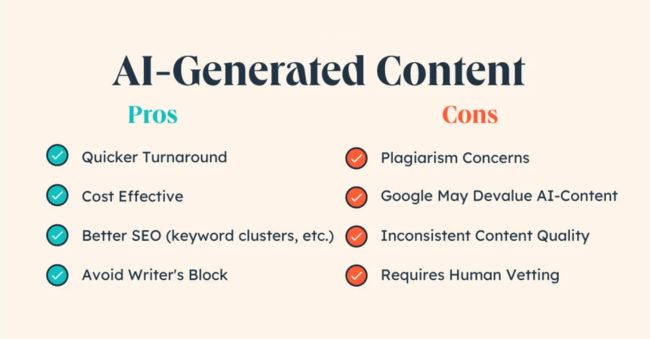We may earn compensation from some listings on this page. Learn More
Artificial intelligence (AI) is transforming content creation in exciting new ways. AI tools can help generate, edit, and optimize content at scale, allowing creators to work faster and smarter.

However, AI-generated content also comes with risks and limitations to consider. This article explores the key pros, cons, and best practices for leveraging AI in your content strategy.
One of the biggest pros of using AI for content is the sheer amount it can produce in a short time. Tools like Copy.ai and Jarvis can churn out blog posts, social media captions, and more in just minutes.
This efficiency and scalability allow creators, marketers, and businesses to generate significantly more content with fewer resources. AI is especially useful for repetitive or data-focused content that requires less creativity, like product descriptions.
While AI can produce content quickly, there are legitimate cons around quality and plagiarism. AI tools rely on existing data and algorithms, so they struggle to generate truly original ideas or content. The writing can also lack nuance and feel robotic at times.
There are also concerns about plagiarism since AI systems draw heavily from other online sources. Content should be carefully reviewed before publication. Using AI content verbatim likely violates Google’s guidelines.
Given the limitations around originality and quality, experts recommend using AI as a writing assistant rather than the sole creator. Here are some best practices:
AI tools excel at optimizing and localizing existing content. For example, writers can use an AI detector to analyze drafts and suggest improvements for SEO and readability. AI can also quickly translate content into multiple languages, adapting it for different local audiences.
The pros, cons, and best practices of using AI tools vary across different content types and use cases. Here is a breakdown of some common content formats:
More and more businesses and individuals lean heavily on AI for high-volume, data-driven content with less need for originality. Keep human creators in the loop for final copy and mission-critical content that conveys brand voice and personality.

Like any new technology, AI comes with both pros and cons for content creation. When used properly as an assistant, AI can enhance productivity and optimize content.
But for quality, originality, and avoiding plagiarism issues, human creators are still essential. By striking the right balance, businesses can reap the benefits of AI without sacrificing the human touch.
When leveraging AI for content at scale, brands must also consider ethics and guard against misuse. Here are some best practices:
With thoughtful policies and ethical oversight, brands can harness AI as a constructive force for content creation. The technology presents amazing opportunities but also responsibilities for its wise and moral application.
Content creation is undergoing a profound transformation thanks to artificial intelligence. When used properly as an assistant rather than sole creator, AI tools can enhance productivity, optimize content, and adapt it for different audiences.
However, human creativity, quality control, and oversight are still essential to produce original, high-quality content that avoids plagiarism issues. The key is striking the right balance between human and artificial intelligence.
By thoughtfully using the strengths of both man and machine, businesses can reap the benefits of AI-powered efficiency without sacrificing the human touch their audiences crave.
With the right strategy, AI and human creators can work together to produce content that is both scalable and engaging.